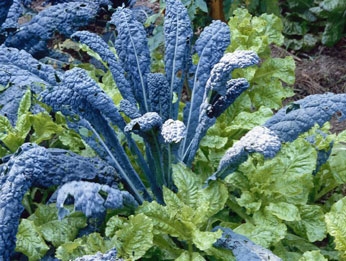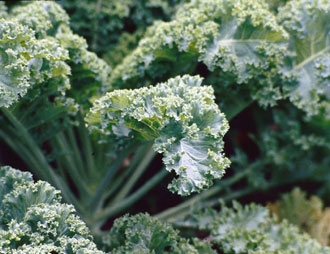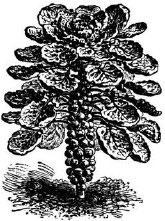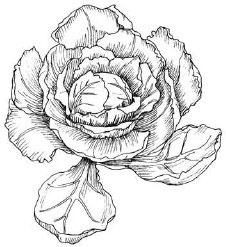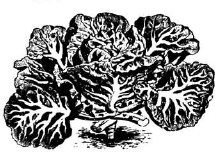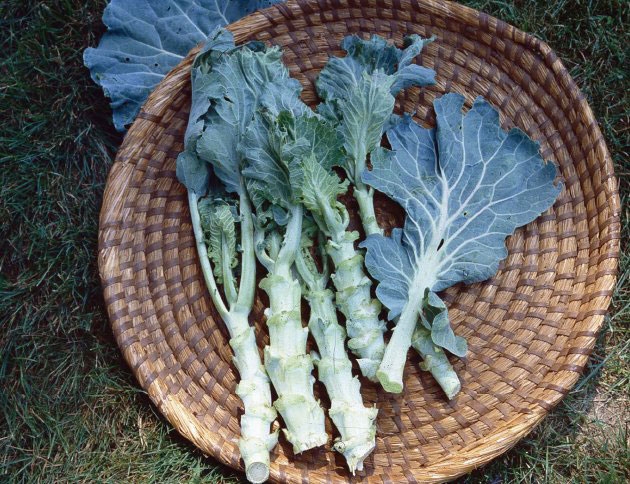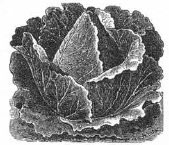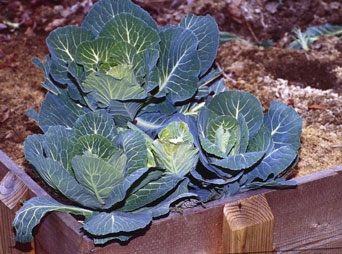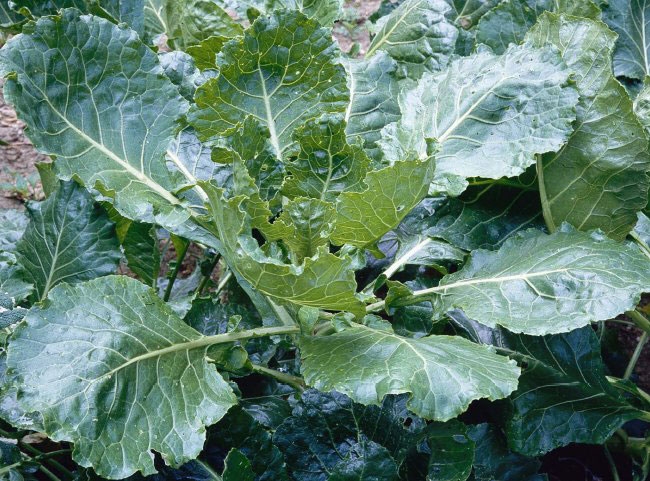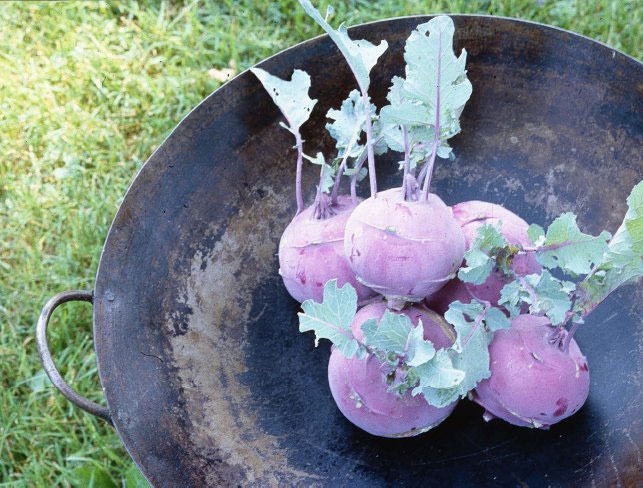However, a German truck gardener in northern New Jersey perfected an early, uniform strain from Wakefield plants, and Peter Henderson eventually obtained rights to it. This became the Early Jersey Wakefield that he made famous in later editions of his
(1865). Seed was released commercially in 1868. This is a cabbage born of seedsmen’s hyperbole, only to prove itself over time to be much better than its creators could have imagined. Today it is one of the classic American heirloom varieties. Originally raised almost exclusively in Bergen and Hudson counties, New Jersey, the cabbage and its center of cultivation eventually shifted to Long Island.
Although it was developed as a field cabbage for commercial culture, Early Jersey Wakefield is particularly well suited for small gardens due to its size. And because it is hardy, it may be raised successfully in USDA zones 5 and 6, but it is not recommended for the South unless planted as in the fall as a winter cabbage. Better for southern gardeners to plant Charleston Wakefield, a variety developed by Henderson in 1892 specifically for the South. In Pennsylvania, large healthy plants often overwinter without protection; Early Jersey Wakefield thrives best, however, when cultivated over the winter in cold frames.
The head of the cabbage is heart-or cone-shaped, forming well-rounded point surrounded by copious pale green leaves. The leaves are sometimes tinged with pink on their “sunny” side. The harvested heads generally weigh 2 to 3 pounds. The young greens make excellent collard; in fact, I prefer cooking the cabbage before it forms complete heads. Charleston Wakefield grows somewhat larger, with more widely spreading leaves, usually a dark green in color. Harvested heads may weigh 4 to 6 pounds.
When we think of collards in this country, we immediately associate them with the South. Many varieties of collards were developed there, and names like Georgia and North Carolina Blue Stem were once quite popular at the turn of this century. Yet the collard was not originally unique to one region of the country, nor was it a specialized type of cabbage. The term is a dialect corruption of colewort, which in the seventeenth century was applied to small kales or to cabbages in their leafy state before they began forming heads. Coleworts were usually the thinnings pulled from the garden to make room for the stronger plants. In the 1702 cookbook of Gulielma Penn (1966, 16), there is a recipe for a beef “pudding” that is made by stuffing a colewort leaf with chopped beef, then boiling it.
By the latter part of the eighteenth century, distinct colewort varieties evolved in this country through accidental crossing between kales and cabbages. Most of these varieties never earned commercial names because they were highly localized in distribution and generally viewed as a poverty food. One of the oldest to survive, however, is the Green Glaze collard, a colewort that evolved out of the Green Glaze cabbage introduced in 1820 by David Landreth of Philadelphia. This collard is distinguished by its color, which is bright lemony green, and the waxy surface of its leaf. This waxy surface forms a natural protection against cabbage worms because they cannot chew through it. As a result, this is also one of the few cabbages that is generally insect free, although the harlequin cabbage bug (a red-and-black beetle) will attack it in the fall.
The mature plants grow about 1 1/2 feet tall and form loose, leafy heads much like lettuce. The plants are tender in regions where winters are severe and therefore must be overwintered for seed-saving purposes. In the North this means digging up the plants and storing them in a root cellar, or potting them up and maintaining them in a cold frame or cool greenhouse. They may be replanted in March in order to have them bloom in April or early May. The spring plants will also produce a good crop of small sprouts.
Collards are best gathered when young or in the fall after nipped by frost. The following recipe is taken from Mrs. E. R. Tennent’s House-Keeping in the Sunny South (1885, 89).
Put one and a half pounds of meat, or half a good-sized jowl in three quarts of water. When it begins to boil skim carefully: in two Hours add the greens, a pinch of soda, and a tablespoonful of salt. When done skin the jowl, remove to a dish, pile the greens around it, and garnish with slices of hard boiled eggs.
Brassica oleracea var. bullata
The American Horticultural Annual (1869, 134) remarked that “no family garden is complete without its patch of Savoys for the table.” And yet savoy cabbages were never grown in the United States as extensively as in Europe, perhaps because their tenderness precludes their culture in many parts of the country. Nevertheless, I stand by my opinion that they are the best sort of heading cabbage, and with few close competitors. The Pennsylvania Dutch always considered the savoy cabbage the very finest sort for sauerkraut, and to serve savoy in any form was always a compliment to guests.
On the other hand, the field of heirloom savoys is not crowded even though many of the names are today quite unfamiliar. Amelia Simmons (1796, 14)—bless her good taste—listed two varieties that were more or less perennial favorites with those Americans who grew them. One was the green savoy, “with the richest crinkles… it will last thro’ the winter.” The other was yellow savoy, “next in rank, but will not last long; all Cabbages will mix, and participate of other species, like Indian Corn.” The old word was cavort, and indeed, Amelia Simmons was one of the first writers in this country to understand the sex life of cabbages. “This is new, but a fact,” she wrote, and I salute her for this frank observation.
The Peale family of Philadelphia included savoy cabbages in many of their paintings, I am convinced out of respect for their status among cooks, for they chose to depict prize-taking specimens. Bernard M’Mahon’s 1815 seed catalog listed only two savoys, the yellow and green varieties advocated by Amelia Simmons. These two varieties remained more or less the American standards until the Civil War.
By the 1890s, American seedsmen were listing as many as seven varieties developed here, one of the finest being Marvin’s Savoy, introduced in 1891. Unfortunately, most of the old varieties are now difficult to locate; a large portion of them are extinct. Personally, I prefer a late Victorian variety from England called January King, which is considered a semi-savoy, the secret I think to its hardiness.
The heads of January King are small and dense, weighing more than a pound. They keep well under refrigeration, as long as two months. The small size of the plants makes this variety excellently suited for the kitchen garden. The leaf coloration is terrific and seems to change daily. The overall color is blue-green, but there are dapples of true turquoise, blushes of purple on the outer leaves, and streaks of violet on some of the leaf stems. Sometimes I think it is too beautiful to harvest, it should just sit there and preen in the sun.
I plant seed in December in my greenhouse. The cabbage thrives in cool greenhouses and makes a good collard. In March I move the best plants to the garden, thus providing myself with a harvest in June. For fall harvests, seed is planted in May. In England the plants are overwintered in the open for harvests in February. Frost (not a hard freeze) mellows the flavor. For seed-saving purposes, seed must be planted in May so that the plants may be vernalized in November, then taken into storage for the winter. In spite of his name, January King is not king of January weather in this country. He needs protection.
There are only two kohlrabies that I would recommend for the small garden, the Purple Vienna and the White Vienna. Both of these were considered “breakthrough” varieties, since they were so superior to the sorts that had been grown up to the time of their introduction. They were illustrated in color in the
Album Vilmorin, the purple variety in 1863 and the white one in 1869, which only added to their acclaim. In 1773 Benjamin Franklin sent John Bartram seeds for a coarse variety of “Cabbage Turnip,” recommending it as a fodder crop for cattle. There are several old large-rooted varieties that would serve this purpose, but the two Vienna sorts, dating from the 1840s, are small and delicate. When young, they can even be eaten raw.
There is no difference between the two except in color. The purple one is shown here, at its peak of perfection for harvesting. The culture is the same as that for cabbage, except that kohlrabies can be planted much closer together, about 8 inches apart. I interplant them with leeks, so that as the kohlrabies finish in June, the leeks grow and fill the space. Kohlrabies are best planted early, as soon as the threat of frost has passed. They mature quickly and will turn woody in hot weather. They can be planted again in mid-August for a fall harvest, but should be gathered before a hard freeze. Freezing will split them.
Kohlrabies are normally peeled before they are cooked. They can be used like turnips, except that the flavor is much more delicate. But why waste the peelings? The Pennsylvania Dutch spread them on paper and dry them. Once dry, they can be stored in airtight jars and used during the winter to make soup. Certainly! Pour boiling water over the dried peelings and let them reconstitute. Simmer until the stock is completely flavored by the kohlrabi peels (about 25 minutes), then strain and discard the peels. This makes an excellent base stock for vegetarian soups.
